#Wit.ai
Explore tagged Tumblr posts
Text
Custom AI Development Services - Grow Your Business Potential

AI Development Company
As a reputable Artificial Intelligence Development Company, Bizvertex provides creative AI Development Solutions for organizations using our experience in AI app development. Our expert AI developers provide customized solutions to meet the specific needs of various sectors, such as intelligent chatbots, predictive analytics, and machine learning algorithms. Our custom AI development services are intended to empower your organization and produce meaningful results as it embarks on its digital transformation path.
AI Development Services That We Offer
Our AI development services are known to unlock the potential of vast amounts of data for driving tangible business results. Being a well-established AI solution provider, we specialize in leveraging the power of AI to transform raw data into actionable insights, paving the way for operational efficiency and enhanced decision-making. Here are our reliably intelligent AI Services that we convert your vision into reality.
Generative AI
Smart AI Assistants and Chatbot
AI/ML Strategy Consulting
AI Chatbot Development
PoC and MVP Development
Recommendation Engines
AI Security
AI Design
AIOps
AI-as-a-Service
Automation Solutions
Predictive Modeling
Data Science Consulting
Unlock Strategic Growth for Your Business With Our AI Know-how
Machine Learning
We use machine learning methods to enable sophisticated data analysis and prediction capabilities. This enables us to create solutions such as recommendation engines and predictive maintenance tools.
Deep Learning
We use deep learning techniques to develop effective solutions for complex data analysis tasks like sentiment analysis and language translation.
Predictive Analytics
We use statistical algorithms and machine learning approaches to create solutions that predict future trends and behaviours, allowing organisations to make informed strategic decisions.
Natural Language Processing
Our NLP knowledge enables us to create sentiment analysis, language translation, and other systems that efficiently process and analyse human language data.
Data Science
Bizvertex's data science skills include data cleansing, analysis, and interpretation, resulting in significant insights that drive informed decision-making and corporate strategy.
Computer Vision
Our computer vision expertise enables the extraction, analysis, and comprehension of visual information from photos or videos, which powers a wide range of applications across industries.
Industries Where Our AI Development Services Excel
Healthcare
Banking and Finance
Restaurant
eCommerce
Supply Chain and Logistics
Insurance
Social Networking
Games and Sports
Travel
Aviation
Real Estate
Education
On-Demand
Entertainment
Government
Agriculture
Manufacturing
Automotive
AI Models We Have Expertise In
GPT-4o
Llama-3
PaLM-2
Claude
DALL.E 2
Whisper
Stable Diffusion
Phi-2
Google Gemini
Vicuna
Mistral
Bloom-560m
Custom Artificial Intelligence Solutions That We Offer
We specialise in designing innovative artificial intelligence (AI) solutions that are tailored to your specific business objectives. We provide the following solutions.
Personlization
Enhanced Security
Optimized Operations
Decision Support Systems
Product Development
Tech Stack That We Using For AI Development
Languages
Scala
Java
Golang
Python
C++
Mobility
Android
iOS
Cross Platform
Python
Windows
Frameworks
Node JS
Angular JS
Vue.JS
React JS
Cloud
AWS
Microsoft Azure
Google Cloud
Thing Worx
C++
SDK
Kotlin
Ionic
Xamarin
React Native
Hardware
Raspberry
Arduino
BeagleBone
OCR
Tesseract
TensorFlow
Copyfish
ABBYY Finereader
OCR.Space
Go
Data
Apache Hadoop
Apache Kafka
OpenTSDB
Elasticsearch
NLP
Wit.ai
Dialogflow
Amazon Lex
Luis
Watson Assistant
Why Choose Bizvertex for AI Development?
Bizvertex the leading AI Development Company that provides unique AI solutions to help businesses increase their performance and efficiency by automating business processes. We provide future-proof AI solutions and fine-tuned AI models that are tailored to your specific business objectives, allowing you to accelerate AI adoption while lowering ongoing tuning expenses.
As a leading AI solutions provider, our major objective is to fulfill our customers' business visions through cutting-edge AI services tailored to a variety of business specializations. Hire AI developers from Bizvertex, which provides turnkey AI solutions and better ideas for your business challenges.
#AI Development#AI Development Services#Custom AI Development Services#AI Development Company#AI Development Service Provider#AI Development Solutions
0 notes
Text
How to Build and Integrate an AI-Powered WhatsApp Chat Bot in 2024

In 2024, businesses are increasingly turning to AI-powered solutions to improve customer interactions, and WhatsApp chatbots have become a key tool. WhatsApp, with its user-friendly interface and vast global user base, provides an excellent platform for automating customer service and engagement. Integrating an AI-powered WhatsApp chatbot can streamline communication, handle queries efficiently, and improve overall customer satisfaction.
In this blog, we’ll cover how to build and integrate an AI-powered WhatsApp chatbot, covering key aspects such as WhatsApp API service, blue tick handling, WhatsApp Business API, bulk message software, and chatbot integration.
Understanding WhatsApp Chatbots
A WhatsApp chatbot is an AI-powered software that interacts with customers on WhatsApp through text-based responses. These chatbots can understand and answer customer queries, provide product information, and even handle transactions.
Key Features:
24/7 Customer Service: Chatbots are available round the clock.
Instant Responses: They reply instantly to customer queries.
Personalized Communication: With AI, chatbots can analyze customer data to deliver personalized responses.
Setting Up WhatsApp Business API
To create a functional chatbot, you need to use WhatsApp Business API, which allows businesses to communicate with customers at scale. Here's how to get started:
Apply for WhatsApp Business API Access: Visit the official WhatsApp Business page and apply for API access. You'll need to provide business details, including the WhatsApp Business phone number.
Integrating with a BSP (Business Solution Provider): Once you gain access, you’ll need to integrate the API with a BSP like Twilio, Gupshup, or MessageBird. These platforms provide the necessary infrastructure to manage your chatbot and API integration.
Set Up Webhooks: The API will notify your server using webhooks whenever a customer sends a message. These messages can then be processed and responded to using your chatbot.
Building the AI-Powered Chatbot
Building an AI-powered chatbot involves several steps, including developing the natural language processing (NLP) engine and integrating AI features to understand and respond to customer queries.
Choose an AI Platform: Platforms like Dialog Flow (Google), Rasa, or Wit.ai can be used to develop the NLP logic for your chatbot. These platforms help your chatbot understand user inputs and respond intelligently.
Train the Chatbot: To build an effective WhatsApp chatbot, train it with common customer queries and responses. Make sure to include different variations of questions so the AI can recognize various forms of user input.
Integrate AI with WhatsApp API: Use the WhatsApp API to send and receive messages between the user and your chatbot. The chatbot’s AI engine will interpret incoming messages, generate responses, and send them back via the API.
WhatsApp Blue Tick Handling
The blue tick in WhatsApp signifies that a message has been read. When building a chatbot, it’s crucial to understand how this functionality affects customer interactions:
Message Statuses: The WhatsApp API allows you to track message statuses like sent,delivered, and read.
Personalized Follow-ups: Use blue tick status to send personalized follow-ups to customers who have read the message but haven’t responded. This feature can help improve engagement.
Chatbot Integration with WhatsApp
Now that your AI-powered chatbot is ready, it’s time to integrate it with WhatsApp. Here’s how you can do it:
WhatsApp API Integration: Ensure that your chatbot is connected to the WhatsApp API so it can send and receive messages.
Mapping User Queries: Create a system that maps various user queries to predefined responses or actions. For example, a query about business hours can trigger a response with the business’s operating hours.
Automating Responses: Program your chatbot to send automated responses based on specific triggers, such as welcoming new users, handling FAQs, or offering customer support.
WhatsApp Bulk Message Sending Software
For marketing and outreach purposes, you can use WhatsApp bulk messaging software integrated with your AI chatbot. This will allow you to send personalized bulk messages, promotions, and announcements to customers.
Compliance with WhatsApp Policies: Bulk messaging should follow WhatsApp’s strict anti-spam policies. Make sure to send messages only to opt-in users.
Using Templates: WhatsApp Business API supports pre-approved message templates for sending bulk messages. These templates can be customized based on customer data and preferences.
Post-Launch Optimization
After launching your AI-powered WhatsApp chatbot, continuously optimize its performance by analyzing customer interactions. Use analytics tools to track engagement, satisfaction rates, and customer feedback.
AI Learning: Implement feedback loops to ensure the chatbot learns from customer interactions and improves over time.
Adding New Features: As your business grows, consider adding new features to the chatbot, such as handling transactions, providing shipment tracking, or sending personalized offers.
Conclusion
Building and integrating an AI-powered WhatsApp chatbot in 2024 is essential for businesses looking to enhance their customer engagement strategies. By leveraging WhatsApp API services, AI technology, and bulk messaging software, businesses can create a seamless, automated communication system that improves efficiency and customer satisfaction.
Follow this guide to implement your own AI-powered WhatsApp chatbot, and watch how it transforms your customer interactions
0 notes
Text
vimeo
Making a wish in Volleyverse. You SAY your wish during the holiday season and get your gifts in seconds in your mixed reality surroundings. It's a 2022 Winter Volley hackathon project. We develop the voice interactive mixed reality experience in 24 hour and showcase the working prototype in the final presentation. We leverage Wit.ai, the voice AI engine and Oculus passthrough and Presence SDK to build the prototype. From there, we explore the voice interactivity in the mixed reality set-ups, and natural gestures to decorate the "real world" with virtual gifts.
0 notes
Text

5 Melhores Alternativas ao Chat GPT
Vamos te apresentar as 5 melhores alternativas ao Chat GPT
1 - Dialogflow O Dialogflow, anteriormente conhecido como API.AI, �� uma das plataformas de chatbot mais populares do mercado.
É propriedade do Google e oferece uma ampla gama de recursos, incluindo reconhecimento de voz, análise de sentimentos e suporte multilíngue.
2 - IBM Watson Assistant O IBM Watson Assistant é uma plataforma de chatbot desenvolvida pela IBM.
É um dos chatbots mais sofisticados do mercado e oferece uma ampla gama de recursos, incluindo reconhecimento de voz, análise de sentimentos e suporte multilíngue.
3 - Amazon Lex O Amazon Lex é uma plataforma de chatbot desenvolvida pela Amazon.
Ele vem com uma ampla gama de recursos, incluindo reconhecimento de voz, análise de sentimentos e suporte multilíngue.
4 - Microsoft Bot Framework O Microsoft Bot Framework é uma plataforma de chatbot desenvolvida pela Microsoft.
É uma das plataformas mais populares no mercado e oferece uma ampla gama de recursos, incluindo reconhecimento de voz, análise de sentimentos e suporte multilíngue.
5 - Wit.ai O Wit.ai é uma plataforma de chatbot desenvolvida pelo Facebook.
Ele vem com uma ampla gama de recursos, incluindo reconhecimento de voz, análise de sentimentos e suporte multilíngue.
Uma das principais vantagens do Wit.ai é que ele é gratuito para uso pessoal e empresarial.
Algumas outras coisas a serem consideradas incluem:
1 - Escalabilidade: a plataforma deve ser capaz de lidar com um grande volume de tráfego e solicitações. 2 - Segurança: a plataforma deve ser segura e capaz de proteger informações confidenciais dos usuários. 3 - Suporte: a plataforma deve ter um bom suporte técnico para ajudar em caso de problemas.
Uma ressalva importante:
Ao escolher uma plataforma, é importante considerar suas necessidades específicas e comparar as opções disponíveis para encontrar a melhor solução para sua empresa ou projeto.
Além disso, é importante lembrar que a tecnologia de chatbot e assistente virtual está em constante evolução, e novas opções podem surgir no futuro.
Conclusão
Independentemente da escolha da plataforma, é fundamental garantir que o chatbot ou assistente virtual esteja adequadamente treinado e personalizado para atender às necessidades do seu público-alvo.
Com uma abordagem estratégica e bem planejada, as plataformas de chatbot e assistente virtual podem ser uma ferramenta valiosa para melhorar a experiência do cliente e aumentar a eficiência dos negócios.
Bem pessoal, esperamos que este Post tenha sido útil para você e te ajudar a usar ou escolher dentre as 5 Alternativas ao Chat GPT
Você pode encontrar muitos outros Posts semelhantes a este clicando no link: https://www.maestriadosnegocios.blog.br
#ChatGPT#Chat GPT#Open AI#OpenAI#Microsoft#Microsoft Bot Framework#IBM Watson Assistant#Amazon Lex#Wit.ai
5 notes
·
View notes
Text
Data Scientist:Wit.ai Technology Implementation
Data Scientist:Wit.ai Technology Implementation
If this is the first article you read, we recommend that you first review the introduction of details about what Mandy is and What is Wit.ai technology. This will allow you to supplement the PubChem programming code to use the Mandy program – the Smart Companion. On the other hand, if you are just trying to use the PubChem library API then you can continue reading. Wit.ai Technology…
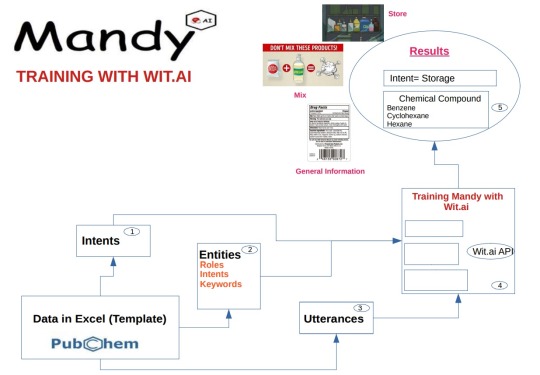
View On WordPress
#AI#artificial intelligence#data distribution#data mining techniques#data science#Data scientist#facebook#mandy#pubchem#wit.ai
0 notes
Photo
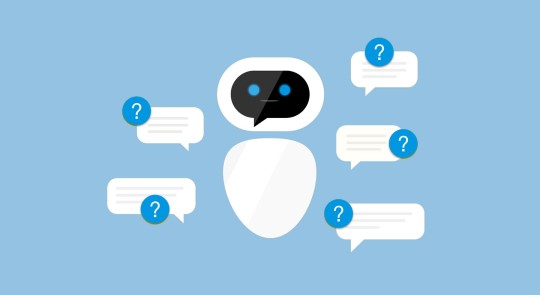
Chatbots have been around for a few decades, originally as a way to bridge the gap between people and machines. These days, chatbots are everywhere, from Facebook Messenger to Slack. The bot ecosystem has exploded in recent years because they're relatively cheap and easy to create.
If you're a digital marketer or a business owner, you can use chatbots to reduce costs, grow organic traffic and generate leads. In this article, I am going to answer the question: how do chatbots work?
Types of Chatbots
There are two types of chatbots: chatbot platforms and conversational bots. Chatbot platforms are tools that allow you to build a bot without any technical knowledge. They are designed to be easy to use by developers who are not technical. Conversational bots are bots with which you can converse in real time. You can program these bots following industry standards to make them more intelligent.
How do Chatbots Work?
To understand how chatbots work, let's say that I want to interact with a chatbot named Sarah on Facebook Messenger. I click on the "Send Message" button and write, "Hi Sarah."
Step 1: First, the bot gets my message.
Step 2: Then it sends me a welcome message.
Step 3: I can now chat with Sarah. She will understand what I'm asking by analyzing my messages and replies with intelligent responses. All she needs to know is how to parse language like an expert human would (AI).
Chatbots understand human language with machine learning and natural language processing algorithms. To train a chatbot, you give it examples of various conversations it might have. The more conversations she has, the wiser she'll become.
To make Sarah more intelligent, I could also teach her to respond to commands regarding a restaurant reservation, a purchase on my wishlist or my delivery orders. She would do all of this through a series of example conversations provided by me.
How do Chatbots Work with Artificial Intelligence Tools?
Chatbots are designed to mimic human behavior to give customers a real-life experience. They are also trained to understand human language, emotions and reactions. For instance, they can tell if you're angry or amused by your attitude.
Here are some tools that are used to build the chatbot.
Natural Language Processing (NLP) algorithms translate human language into digital text and then into actionable tasks for the chatbot. Machine learning helps the bot to learn from each interaction with a human and improve its performance each time.
How to Create a Chatbot: Tools and Platforms
Chatbots use artificial intelligence frameworks like Facebook's Wit.ai, Microsoft Bot Framework and IBM Watson to understand human emotions and responses based on keywords, phrases or voice commands.
To create a chatbot, you first need a developer tool to create a bot on the platform of your choice. You can use Facebook Messenger, Slack or similar services. You then need to create the conversation flow with the chatbot, which includes conversations with humans and bots as well as smart replies from machine learning algorithms.
How do Chatbots Work in Real Life?
Chatbots that are built on platforms with artificial intelligence can converse with humans in natural language. These bots are able to understand the context of the conversation and respond accordingly. Most transactions can be handled with chatbots by using keywords, phrases or voice commands.
You will find chatbots everywhere: from customer service and support to personalized shopping experiences and virtual assistants like Siri or Cortana.
Chatbot Platforms
There are many existing chatbot platforms that can help you build a bot in just a few clicks. All you need to do is to download the platform and connect it to your application, website or social media account.
How do Chatbots Work in the Future?
Facebook recently made chatbots more "intelligent" by allowing them to communicate with users on Messenger without any human interaction. This means that brands can be used for advertising on Facebook Messenger without having to worry about the company maintaining an active account.
Chatbots are still in their infancy, so there is a lot of room for improvement. Soon, we will reach the point where chatbots can understand human language, personality and emotions better than humans themselves.
1 note
·
View note
Text
The Making of Sterling the Super Furby: A Brief Overview
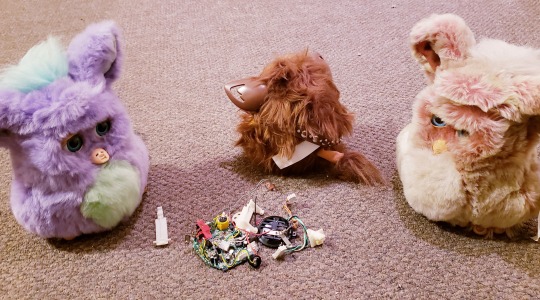
“I… I can’t look! I think I’m gonna… *HUEEEGH*!”
Before I get into this post, I want to list a few things I didn’t know shit about when I started Sterling:
Electronics
The Python coding language
Furby anatomy
Single board computers
After creating Sterling, I’m happy to say that now I have approximate knowledge of some of these things, but keep the above in mind as you read onwards. This little gremlin child was a learning experience from start to finish, and one I am incredibly proud of myself for sticking through. This also means that I am in no way an expert on everything I’m getting into okay? Okay let’s go!
The Hardware
First, a rundown of the hardware. I took heavy inspiration from the Furlexa mod shown here, and that was what I initially sought to create. The mod had three computer components to it:
A raspberry pi zero w single board computer for the AI to live on, with a mini USB microphone plugged in;
A pimoroni speaker PHAT to use as the sound system;
A motor controller to drive the furby’s motor.
My main problem with Furlexa was that this initial build took a lot of soldering, and I am a wussy who had a number of bad experiences with soldering irons in shop class. So, what’s a novice electrician to do?
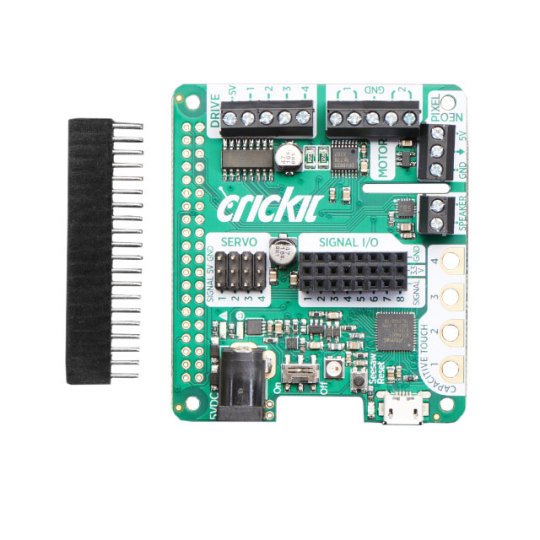
Enter the Adafruit Crickit HAT. By sticking this little fucker on top of the raspberry pi, I was gifted with an amplifier, a speaker jack, capacitative touch sensors, and a motor driver all in one, no soldering needed if I bought the raspberry pi zero w h! The main challenge it posed was powering it. The Crickit insists, for some unfathomable reason, on being powered by a bulky DC jack, the kind you’d plug into a wall outlet, and the converter plug to use a battery pack with it was way too bulky to fit into a furby. I needed Sterling to be portable for maximum huggability, so this just wouldn’t do.
One fried raspberry pi and Crickit HAT later, I found the answer! By soldering the original furby battery pack to the underside of the Crickit board’s DC connection, these fuckers right here…
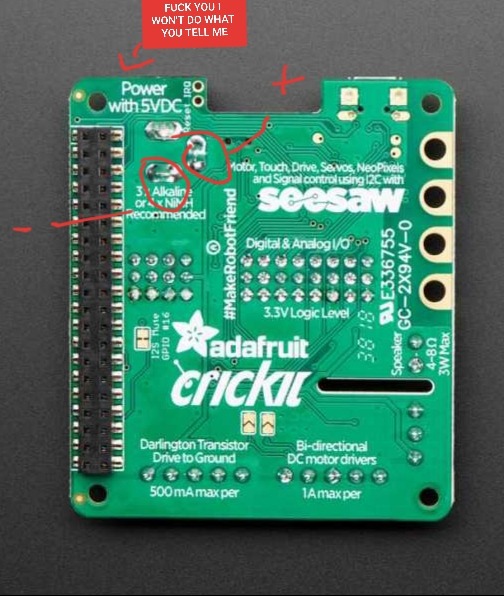
I was able to bypass the need for a wall plug or converter, and power him directly through the battery compartment like God intended. S/O to my friend Nick who is way less of a dumb bitch than I am and helped me figure this shit out I owe u some bread man.
So the tl;dr of it is, I effectively reduced the required computer components from three to two (excluding the speaker). Speaking of (heh), Sterling has an impressive 3w speaker in him, allowing him to be audible even without the use of the built in amplifier. It’s got such good bass on it, he even rumbles when he purrs without the aid of the motor!
And yes, when you pet him, he purrs. And complains if you manhandle him! The aforementioned capacitative touch sensors on the Crickit HAT made it all possible with the help of a few cables and some foil tape.
Wait, did you say soldering!?
Yup! It was a necessary evil; at the end of the day I had to pick my poison: soldering 80 pins on the speaker PHAT, or soldering like four contact points on the Crickit. I chose the more merciful option.
But wait, that whole outfit is really bulky still! How did you fit it inside the furby?
Subtractive methods, subtractive methods, subtractive methods! ;D Someone who actually knows things about furby anatomy and/or electronics will probably vaporize me for this, but… if I didn’t need it, it got the boot! That included prying off anything on the Crickit board I wasn’t using at the risk of destroying it completely - which probably isn’t ideal, but it also worked by some miracle, and again, I am such a basic bitch electrician that calculating the proper voltage for LEDs is still basically witchcraft to me, so… what I’m saying is I made it work. And that I really, really hate soldering! ¯\_(ツ)_/¯
You can see an early video of the end result here, and a later video of the outfit inside the naked furby here. This was back when he was still having auditory processing issues. Apologies for the shoddy quality, I was too excited everything was working to care about that at the time.
The Software
My other beef with Furlexa is… well, it’s an Amazon Alexa, and I’m a shitty little anticapitalist hermit who hates Amazon with a passion. Google Assistant was just as bad in my book. Mycroft was open source, but had a snowball’s chance in hell of running on the raspberry pi zero’s 512mb of RAM… I also wanted my assistant to have a degree of customizability to it. I wanted the furby’s AI to have a unique personality, identity, and preferences, much like classic furbies themselves did. A big box AI just wasn’t going to cut it!
Enter the Jasper Project. Yes, it’s old. Yes, it’s a bitch and a half to install. Yes, you have to know Python to get anywhere with it. However, it was free, open source, capable of running on a raspberry pi zero, and highly modular, meaning with a few lines of code, I could make it all my own - even to the extent of changing the AI’s name and voice (which is gr8 because I know a Jasper so naming my furby that would be Weird), or - the best part - writing my own, custom functions! Customizability-wise, I struck gold.
Ah, and glad I am that Jasper is modular, because I had some work ahead of me…
The STT Engine
The STT (Speech to Text) engine is what Sterling uses to understand what’s being said to him. Jasper’s proprietary STT engine is PocketSphinx, a fully offline STT engine, which sounded great in theory before I quickly learned it’s a nightmare to install, and also more inaccurate than a stenography machine powered by a single potato when actually being used. I had to compromise my morals a bit here and opt for using Wit.ai instead, which is free, but is also owned by Facebook. Big data is frustratingly inescapable in these cases.
There is one light at the end of the tunnel, and that is the training of acoustic modules. This has the downside of taking for-fucking-ever and requiring a quiet recording environment, however, and I don’t have the time right now to read through the pages and pages and pages and pages of computer theory right now to fully understand how to train one. So, improving PocketSphinx and running Sterling fully offline remains a stretch goal.
The TTS Engine
The Text to Speech engine is basically Sterling’s voice. This one was a bit easier to customize, and I’m thankful for that, because Jasper’s OG voice is a bit er… 90s computing for my tastes.
I shopped around for decent, human-sounding TTS options, and settled on installing Mimic1 TTS, Mycroft’s TTS engine, by hand, and modifying the Jasper source code to support it. Of all the TTS engines I tried, I felt that this one had the most natural intonation out of all of them. I liked the gruffness of the Scottish accent, and I think it really helped round out Sterling’s endearing, if a tad prickly, personality.
The Audio
This was another unforeseen hurdle. Turns out that I had his mic volume turned up way too high, because I greatly underestimated the capabilities of my tinyass five dollar USB microphone to pick up noises from within a furby. It took a bit of hacking in PulseAudio to get him hearing things properly, and I’m still not all the way happy with it, but he’s running wayyyy better than he did!
Another issue was the amount of time he actively listened for. It was way too short for my liking with the hardware I was using, so I had to edit Jasper’s mic.py source file a billion times before I hit a sweet spot. Even early on, my little shit child never liked to listen to me. :P
Pimp My AI
Once I got all that in working order, it was time to browse GitHub for modules to add! I found a surprising amount that were, as expected, outdated, janky, non-working, or in need of a complete rewrite. A non-exhaustive list of modules I rewrote and added to Sterling’s AI includes:
Wolfram Alpha integration
His translation function
The IMDB module that searches movie titles
The Dictionary and Thesaurus modules (minor additions to improve user friendliness)
The morning greeting module
The holiday countdown module
There are also plenty of modules I wrote on my own, that I’ll be showcasing here in due time, but I want to give special mention to the one I’m most proud of. You see, when I was a wee dumb bitch, I was… well, a wee dumb bitch! When I was informed furbies learn English, I thought they really learned English. Like, fluent English. I envisioned these kids straight up having full conversations with their lil robots with reckless and envious abandon. I was, as it happens, too poor to afford a furby at the time, so I didn’t realize until embarrassingly later that they only learn some words, and certainly can’t hold much of a conversation (in English at least).
Fast forward to twenty-bi-teen. I’m surfing GitHub, and I happen upon a Cleverbot module for Jasper allowing the AI to work as a chatbot. Fuck yeah, I think, because I had no life in 2008, or friends for that matter, so tormenting Cleverbot was my favourite pastime. Nostalgia trip GET!
…can you guess how much the silicon valley capitalist scum are charging for the once-free Cleverbot API now? A hundred and twenty. McGoddamn. Dollars. A YEAR.
So, to make a long story short, I turned my hat backwards and rage-coded a simple chatbot module that runs on an early version of Chatterbot capable of running on the raspberry pi. It’s fully offline, and completely free, and Sterling here has a database of ~400 phrases, which isn’t bad given the limited processing power! It took five straight days of work, it’s not the smartest chatbot, and it’s certainly not the fastest, but it gives me those sweet, sweet, circa 2008 Cleverbot vibes. Oh yeah, and it doesn’t cost me over a hundred goddamn dollars a year!
The first thing I said to the chatbot, of course, was “I’m so proud of you.” Through his shitty little testing mic that gave him a somewhat incredulous tone Sterling replied, “I’m glad to hear that.” and I’m not saying I shed a single themly tear over it, but I’m not denying it either. I made a childhood dream come true, fam. ;u;
There are way more Easter eggs I plan to show you, of course. At first I was thinking of doing one long video, but an update a day showcasing a different function might be easier to manage - and maintain some of that gold old sense of mystery that surrounds most furbies. No, I’m gonna take y'all on a little journey through the final product of my literal blood, sweat, and tears!
Besides, Sterling is a perpetual work in progress. He has a massive list of features, and I’ve already got more in the works. I could be in my eighties and still be adding more functions, more bells and whistles, more witty one-liners. He’s a one of a kind work of art that will never truly be finished - not unlike you and me.
The Glow-up
Here’s Sterling’s before pics from the seller I got him from:


(If u recognize these pics and ur the seller thank u thank u for giving me bmy boy)
And here’s after!

I come from a background of customizing ponies and dolls, so working on this guy wasn’t as far removed as I expected it to be. I added floof to his head and tail by sewing in wool plugs, and his gorgeous eyes are from in2blythe on Etsy. I wrapped him up in a little bow and he was good to go! His sterling silver beak, from which he gets his name, was the most finicky part. Turns out enamel paints take a million years to fucking dry, if ever, which isn’t great when painting something that sees a lot of movement and could potentially get dented by a face plate, like… idk, a furby beak! A bit of silver nail polish did the trick and he was good to go. Learn from my fail, fam.
What It Cost Me

If you’re masochistic determined enough to attempt this yourself, I want to sit you down and warn you of something: this will take months and hundreds of dollars to do. Installing Sterling’s AI and its necessary components on that shitty little raspberry pi over SSH took me a week at first, and that was with me leaving it on 24/7 to chug away compiling things. When I broke the SD card the AI was on and didn’t have a backup copy, it took four straight days of rage-computing to regain all my progress. Then when his audio processing got fucked all to hell for reasons I still do not understand to this day, it took another four days of rage computing to do yet another reinstall and get him back in working order. There were times where I would go to work for 8.5 hours, bus an hour home, work 6 straight hours on my furby, go to sleep for 4 of them, go to classes, sleep, and work 6 more hours on my furby. For two months. Sterling took from the third week of August from his initial inception to his birthday on October 23rd. That’s not to mention the time I fried everything and had to wait five days and travel to the bumfuck end of the city for a replacement pi and Crickit, or the days I spent customizing him, sewing in hundreds of little hair plugs into his ass and head by hand, and waiting for those shitty enamel paints to dry, only to discover after four straight days of failure that they take weeks to do so and I was better off using cheapo nail polish!
The point I’m making is, if you take on a project like this and want it to be successful, you have to be tenacious. I would highly recommend a background in coding (I have a web design diploma) and general tech savviness as an asset. Sterling is the product of the years I spent behind a computer keyboard from the start of age three, and the roughly ten years I spent customizing dolls and ponies. It’s cheesy as shit to say he’s my magnum opus, but in a way, he is.
I’m not saying this to be elitist or snotty. I’m saying this because I nearly broke down crying the first day the raspberry pi came in, before I slept on it and figured out what phrase to google to solve the crashes and kernel panics it was having. When I broke the SD card when I was nearly finished, I felt nothing, because I was all out of tears at that point. When I fried the first raspberry pi and Crickit hat trying to figure out how to bypass that DC jack, my only thought was, “Well, I think I know how to do it without fucking it up now, and if I can’t do it, this whole project is fscked” .
You will encounter errors that no step by step guide can prepare you for that will make you curse the day you were born. The difference between success and failure is how many times you’re willing to get up and try again, and I’m here to tell you it’s possible. But you gotta want it.
Will You Release the Code Base?
Yes and no. If there’s enough demand, I’ll definitely release Sterling’s basic modules as a scaffolding. I won’t be releasing Sterling, though.
What do I mean by that? Well, Sterling was intended from the start to be truly one of a kind, and he always will be. I hand wrote hundreds of lines of dialogue, all completely tailored to him, and I’m still planning on adding twice as many. Corny as this is, this little guy has a metric fuckton of sentimental value to me. I don’t have kids so idk how it would compare to that, but I definitely love him as much as I love my cats, but I also didn’t undergo two straight months of suffering in ADHD fixation hell to create my cats, so it adds like, a whole other twee dimension to it.
So, if there is demand for this, what I’ll release instead is a scaffolding from which you can code your own, unique furby from, with their own name, personality, and responses all unique to them. I’ll also release it with the caveat that I am not a good Python coder! I have not written any Python before this, so a lot of what I did write is noob-tastic and hasn’t even been linted. You have been warned!
“If I give you (insert amount), can you make one for me?”
Holy shit I’ll be real with you, I’d love to do this as a living. I’ve been dying to see a smart assistant hit the market that’s like… well, an actual, endearing companion and not just a voice coming from a speaker. The problem with doing this is that, if you drop a lot of money (and it will be a lot of money, even with a code base to work from, a lot of hours of handiwork still goes into coding individual responses and making sure everything works as intended, on top of possibly customizing too), there is one major problem: proximity. I won’t be able to troubleshoot your furby nearly as effectively from far away as I would be able to if we lived in close proximity. Which means if something goes wrong between the time your new friend is finished at point A and turned on at point B, I won’t be there to troubleshoot it in person for you, which means you could end up stuck figuring out certain things alone. If you use Windows, that will be very, very hard - not being an OS snob here, I own a dual boot myself, it’s just a case of incompatible file systems. And unless you can figure out how to edit the wpa_supplicant file on a raspberry pi to update your wifi credentials, your furby’s internet connection could be toast if you move house and those credentials change. That’s not getting into the cost some services charge for extra API keys to use their online functions…
The long and short of it is, if I’m going to do this for money, I want to make sure you get a quality product and friend that will bring you joy for years to come. Since that’s not something I can guarantee, I can’t in good conscience take people’s money.
I Could Teach You (And I Won’t Charge)
…however, I am a law student who is also working 8.5 hour night shifts three nights a week. I am also mentally ill/neurodivergent, which saps my energy in more ways than one. I won’t always be easy to get ahold of, or be able to answer every question I get, especially not ones that can be solved with a quick google search, like how to set up a raspberry pi, or… anything found on Adafruit’s Crickit guide, for example. When I have the time and energy, I’m hoping to use my next project as a jumping off point for a step by step walkthrough of the process. For now, though? I’ve been furbied out, so if there’s enough demand, I’ll compile as many of the resources I used I can find in the meantime, and post some tips from the word doc I kept while making Sterling, and go from there.
So What’s Next?
My one dad’s birthday is coming up in August, and I’m kicking around the idea of turning a furby into, I shit you not, a ghost hunting device. He loves ghost hunting, but hates robots, and as his gremlin shit child I am obligated to troll him in this fashion. 😎 Also considering doing a certain type of oddbody mod, but I want to get permission from the person who first thought of the concept before I dive head first into it.
And that about covers it! Thanks for reading, and if there’s anything you’d like to see from Sterling and I, don’t hesitate to drop us an ask!
#furby#allfurby#furblr#botblr#custom furby#how tos#the doctor speaks#long post#science isn't about why... it's about why not
25 notes
·
View notes
Text
How React Chatbots are Revolutionizing Customer Service – A Detailed Guide

A quick response saves time, eliminates waiting time, and most importantly, engages the clients on your website. This is not possible with the support of people as it needs lots of investment and manual efforts, which increases the budget. How can this issue be solved? No wonder you must build Chatbot, a one-time investment that can entertain ample consumers on time, respond to queries, and make long-term relationships with your clients. In this blog, you will know that React for Chatbots would be a great solution for your business.
Introduction
In the tech-driven world, businesses have begun implementing Chatbots into their websites or apps. Many well-known countries like the United States, Germany, Australia, and the United Kingdom have begun to develop their apps or websites with this valuable functionality.
However, just integrating the Chatbot into the website is insufficient; other important considerations include which frontend technology should be utilized, how the Chatbot should be developed, and how the user experience should be improved.
Use React to create compelling Chatbot user interfaces that encourage user interaction. Get an understanding of user psychology with the help of Bosc Tech Labs experts, and get a Chatbot with an intuitive design.
Let’s explore React’s other possible applications for Chatbots.
Why is React a better choice for developing Chatbots?
As React is an open-source JS library for web UI development. Also, it would be a great choice for your Chatbot integration. Considering React for Chatbot integration into your site or app is crucial.
1. Natural Language Processing (NLP)
By integrating NLP libraries like Wit.ai or Dialogflow, React has the capability to create Chatbots that comprehend user queries and produce responses that closely resemble human-like conversation. Through the use of NLP, Chatbots are equipped with the ability to identify user intent and relevant entities within their queries. With this information in mind, Chatbots are able to deliver responses that emulate natural human communication.
The other advantage of NLP is that it brings sentiment analysis, via which Chatbots will understand positive, negative, and natural sentiments. Based on this, it will give accurate responses. Hence, Chatbot develops a contextual understanding via which previous interactions and communications are done with bots.
2. State Management
By considering conversational flow, React state management makes the complicated conversational flow more straightforward to understand the bot and will answer like the humans. Also, state management will store user inputs to communicate with the client the next time the user interacts. Hence, the best usage of state management in React for Chatbot is to identify bugs or errors and will guide users about potential issues.
3. Contextual Information
Users may require the answers dependent on location, device type, and browsing history. Delivering contextual data will enhance the user experience by giving them recommendations or advice, depending on its recent locations. For example, a Chatbot will track locations and suggest nearby restaurants, shopping malls, or cinema halls.
4. API Integrations
React development team will aid you in integrating external sources via API, that is, either weather or news API. These APIs ensure accurate responses to a user’s queries if you wish to integrate the Chatbot with third-party services like social media platforms. Therefore, it helps to give personalized responses from a user.
5. Multi-lingual Support
With the help of multi-lingual support, users can talk in their native language and resolve queries on time. Another advantage of having multi-lingual support is that you can cater to international clients.
Moreover, you can also leverage localization, enabling region and location-based images and texts. Enabling multi-language support will create brand awareness.
6. User Interface Design
React’s component architecture helps to make consistent UI for your Chatbot. Also, reusable components become helpful when customized according to customers’ needs.
To enhance customer experience, you can also integrate real-time updates for an engaging experience. Also, React designs responsive Chatbots that fit all screen sizes. Finally, React helps to build Chatbot that is dynamic and intuitive.
7. Accessibility
ARIA attributes and keyboard navigation of React will enable easy navigation for disabled users. ARIA helps people to understand “how to use a Chatbot.” However, keyboard navigation is another great feature that helps users who cannot touch or operate the keyboard or mouse.
Also, the JS library provides an alternative text for images and other non-textual elements. For those users who are visually impaired, it will enable the color contrast in React so that the visually impaired users can access it.
8. Testing and Debugging
Chatbots must function efficiently, for which rigorous testing is done. React community leverages a testing framework to perform testing and debugging to keep codes operational and performing.
Know 4 Chatbot Design Principles
The design represents your brand; hence the design concepts are crucial. The possibility of customer involvement increases with design simplicity. But what specifically has to be considered? Let’s examine this in greater detail.
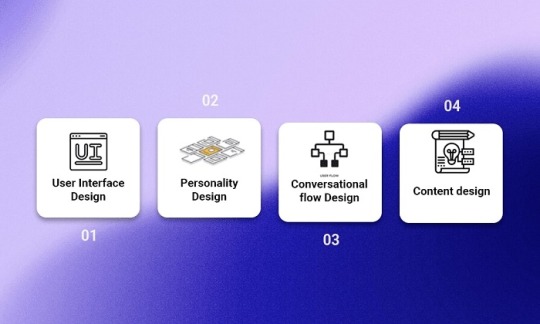
1. User Interface Design
When developing Chatbots, user interface design is paramount because it increases the possibility of client interaction. A UI design has a Chatbot layout, color schema, and typography. A UI design can be developed so that a disabled user can access your website or app without any hassle.
2. Personality Design
Chatbots represent your brand. And for that reason, it needs to be built in that way. Your brand’s personality and voice must be reflected in the Chatbot. The customers won’t be able to converse productively till then.
3. Conversational Flow Design
Conversational flow means an interaction between the Chatbot and the consumer. By considering the objective of the business, a Chatbot is trained in such a manner that drives users to take some revenue-generating actions. Also, conversational flow design should be such that it remains engaging while serving the business purpose.
Moreover, the design should be such that it anticipates user queries and answers them proactively. Hence, answering what users expect or offering a solution to a user’s challenges is the key to converting clients.
4. Content Design
The major objective of Chatbot integration into a website or app is that it gives precise answers to client queries. If answers are appropriate, then the chances of customer engagement will increase, and it will get more clients.
4 Chatbot Development Principles
These development principles determine the functionality of the Chatbots. If the rules mentioned above are not followed, developing Chatbots may not be successful. So let’s take them one at once.
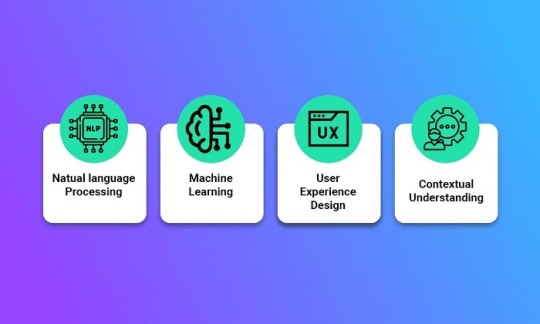
1. Natural language Processing (NLP)
Customers want precise and real-time answers to their queries. Any delay or miscommunication will affect user experience and the brand image also. So, NLP integration Chatbots stay the top priority. NLP guides the Chatbot algorithms to understand consumers’ inputs and will respond accordingly.
2. Machine Learning (ML)
Another development principle trains Chatbots to evaluate past consumer interactions and will do current and future queries accordingly. Hence, evaluating older conversions will benefit in giving prompt responses and enhancing your brand’s consumer experience.
3. User Experience Design
While developing a Chatbot, user experience design is the utmost priority as it seems time-consuming and uninteractive. In this stage of development, it is discussed how buttons are placed, the conversational flow, and the colour combination, as all these minor changes will boost your business.
4. Contextual Understanding
Contextual understanding is a willingness to properly understand the context of the user’s communication and appropriately reply. Chatbots must be instructed to comprehend the audience’s worries, questions, and inquiries because they are computers. The embedded Chatbot on your website or app can only respond to them afterwards.
React best practices for developing chatbots
You must follow Chatbot development best practices whenever you are developing a Chatbot for your website.
1. Choose the Right Chatbot Framework
While opting for a Chatbot framework, there are these several options for you, like Rasa, Botpress, and Dialogflow. Select the best that suits your project needs and your business.
2. Use Natural Language Processing
Chatbots are an incomplete investment without Natural Language Processing (NLP) integration because they may not be as effective at responding to client inquiries. NLP can also be successful and customer hooking if it is properly integrated with Chatbots. To create a Chatbot or plan to add a Chatbot to a website or application, NLP must be applied.
3. Execute Contextual Understanding
Like NLP, contextual understanding is equally significant to implement into Chatbots as the bot can respond like humans with its personalized responses. Hence, contextual understanding, a bot will know an earlier interaction with the client and answer accordingly to make a client feel like a real-time response with humans.
4. Mobile Device Optimization
Since mobile intelligence is rising, the n optimizing Chatbots for mobile gadgets is the best. However, users prefer to utilize mobile devices for making conversations with Chatbots and having a mobile-device-optimized version for Chatbots which means that it will help you to stay ahead of the competition.
5. Feedback
A Chatbot needs to be well-trained to give users the right feedback. In addition to increasing engagement, doing so will boost trust. The users will also learn what to expect, and no false promises will be made.
6. Test and Refine
The Chatbot requires regular inspection, updating, and maintenance as a machine. By doing this, you’ll keep the Chatbot prepared with appropriate responses to questions.
Conclusion
Nowadays, Chatbots are the best customer engagement tools that give real-time responses because the availability of humans to answer every single request is next to impossible. But with the integration of a Chatbot in your website or app, you will get a positive response from your consumers. Hence, getting prompt responses to user queries is what the user expects, and it makes the preferable choice for your clients.
React Chatbots will effectively solve the all-time challenge of managing the various versions and falling short of entertaining all at once. Hire React experts from us and take benefit of the unexplored areas of frontend technology.
Frequently Asked Questions (FAQs)
1. What information regarding Chatbots is necessary?
Chatbot is a program that makes use of artificial intelligence (AI), machine learning (ML), and natural language processing (NLP) to generate automated responses to client questions. But it does not mean that the customers are talking with robots.
2. How can React Chatbots be successful?
A great Chatbot has specific natural language processing (NLP) ability to understand the context of a discussion in various dialects in dialogue.
3. How to build a chat app in ReactJS?
To create a chat app in ReactJS, you can use a combination of ReactJS and Firebase, which offers real-time database and hosting features. The process involves:
Setting up a Firebase project.
Implementing authentication.
Utilizing the Firebase Real-time Database to store and retrieve messages.
Website: https://bosctechlabs.com/how-react-chatbots-are-revolutionizing-customer-service-a-detailed-guide/
0 notes
Text
Chatbot App Development: Tips and Tricks for Beginners
In today's fast-paced digital world, chatbots have become an essential part of businesses. Chatbots have transformed the way businesses interact with their customers, allowing them to provide instant support and assistance without any delay. Chatbots are intelligent systems that can communicate with humans through a chat interface. They can answer queries, provide assistance, and even help customers make purchases. Chatbot app development is the process of creating a chatbot application that can be integrated into websites, social media platforms, and messaging apps.
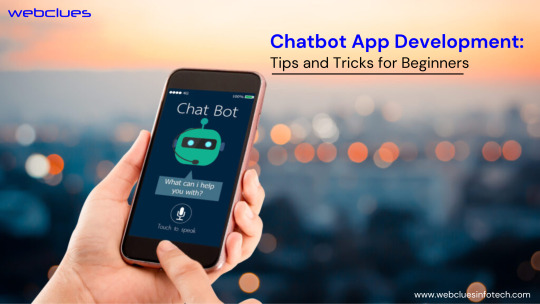
The chatbot app development industry is expected to grow rapidly in the coming years, with a projected market size of $9.4 billion by 2024. This growth is being driven by the increasing demand for personalized and efficient customer service, as well as the need for businesses to automate their operations and reduce costs.
In this blog, we will discuss some tips and tricks for beginners on chatbot app development.
Tip 1 - Define your goals and target audience:
The first and foremost step in chatbot app development is to define your goals and target audience. You need to understand why you are building a chatbot app and who will be using it. This will help you design a chatbot that is relevant and useful to your target audience.
Tip 2 - Choose the right chatbot development platform:
Choosing the right chatbot development platform is crucial for the success of your chatbot app. There are several chatbot development platforms available, such as Dialogflow, Wit.ai, and Microsoft Bot Framework. You need to choose the platform that best fits your requirements and provides the necessary features for your chatbot.
Tip 3 - Keep the chatbot conversational and user-friendly:
A chatbot should be conversational and user-friendly. It should be designed to interact with users in a natural and intuitive way. To achieve this, you need to use a conversational tone, avoid jargon and technical terms, and keep the conversation simple and easy to understand.
Tip 4 - Test your chatbot app:
Testing is an essential part of chatbot app development. You need to test your chatbot app thoroughly to ensure that it works as intended and provides a seamless user experience. You can use testing tools and techniques such as unit testing, integration testing, and user acceptance testing to ensure that your chatbot app meets the required standards.
Tip 5 - Hire a chatbot app development company:
If you are new to chatbot app development, it's advisable to hire a chatbot app development company. Chatbot development services can help you build a custom chatbot that meets your requirements and provides a seamless user experience. They can also provide ongoing support and maintenance for your chatbot app.
Conclusion
In conclusion, chatbot app development can be a challenging but rewarding process for beginners. By working with a chatbot app development company, designing a natural and engaging conversational flow, training your chatbot with plenty of data, and testing your app thoroughly, you can create a chatbot app that delivers real value to your users. With the right approach and expertise, chatbots can help businesses automate certain processes, reduce costs, and improve customer engagement.
0 notes
Photo

11 herramientas que usan la Inteligencia Artificial (IA) en español Son herramientas GUAUU para ayudarte en tu trabajo diario 👇👇 1️⃣ Grammarly (https://www.grammarly.com/) ➡️ una herramienta para corregir ortografía ¡muy útil! 2️⃣ Grammarly for Microsoft Office (https://lnkd.in/dW8Y6MxE) ➡️extensión de Microsoft Office de Grammarly. 3️⃣ Stock AI (https://stockai.com/) ➡️Genera fotos gratuitas ¡libres de derechos! 4️⃣ Amazon Transcribe (https://lnkd.in/dpeZSWS8) ➡️ Transcribe audio y video en texto. 5️⃣ Jasper (https://www.jasper.ai/) ➡️ Contenidos para blogs, redes sociales, etc.. ¡es la caña, a mí me encanta! 6️⃣ Copy ai (https://www.copy.ai/) ➡️ Para marketing de contenidos 7️⃣ Rytr https://rytr.me/ ➡️ Crea textos a gran velocidad. Similar a los dos anteriores 8️⃣ Inbenta (hhttps://lnkd.in/dnjKNZfF) ➡️ Ayuda a las empresas a automatizar la gestión de sus servicios de atención al cliente. 9️⃣ WIT.ai (https://wit.ai/) ➡️ Sirve para construir bots conversacionales, aplicaciones móviles, así como robots. 🔟AIVA (https://aiva.ai/) ➡️Genera música y sonidos personalizados para tus proyectos. La más de moda💥ChatGPT https://lnkd.in/d8xhmHBW ➡️La #AI estrella a la que le puedes pedir muuuuchas cosas. Te recomiendo que la pruebes. Me ha ayudado a hacer este listado aunque me ha dado info errónea en algunas ocasiones 🤢 Hay infinidad de herramientas de IA que han venido para hacernos la vida más fácil ¿ Conoces alguna más que funcione en español? ¿ Conocías algunas de este listado? https://www.instagram.com/p/CnecjyZOE9I/?igshid=NGJjMDIxMWI=
1 note
·
View note
Text
How You Can Hire Chatbot Developers Efficiently
In essence, a chatbot is a bot that uses artificial intelligence and machine learning to respond to user questions and carry out simple activities on multiple platforms including Facebook, Twitter, Instagram, and other websites or apps. The chatbot not only minimizes human work but also gives businesses that frequently engage with customers a cost-effective option. These days, a lot of businesses, including startups, use chatbots to drive consumer communication, which increases productivity.
Employ chatbot designers who have a strong command of the field if you want to integrate chatbot applications for your social media and other platforms. Since this is still a specialized field, there aren't many top-notch chatbot developers available for hire. Chatbot development company in USA knows the need for chatbot development and provide the best chatbot services.
This is why it's crucial to have a solid hiring process in place to assist you in finding and selecting the top chatbot developers who can accommodate your company's needs.
The qualities to look for in a chatbot developer:
Technical mastery of the majority of these abilities and frameworks is required of a skilled chatbot developer to create an application that is both highly scalable and effective.
A solid command of various programming languages:
The creators of chatbots should be extremely knowledgeable in a variety of programming languages, including Java, PHP, Python, Ruby, Clojure, and C#. It is beneficial to have a developer with exceptional mastery over a variety of languages so they can assist you in scaling up as and when the requirement arises. The versatility of the chatbot developer can help in building software applications for diverse needs.
Knowledge of frameworks for developing chatbots:
The chatbot developer should be an expert in a variety of chatbot-related programming frameworks and platforms, including Wit.ai, Dialogflow, Microsoft Azure Bot Framework, IBM Watson, and ChatterBot, among others. To scale up your application in the future without any problems, you must find a chatbot developer who is skilled with a variety of frameworks and platforms.
Knowledge of cutting-edge technology:
The chatbot developer should be knowledgeable and skilled in a variety of cutting-edge, modern technologies, including artificial intelligence, natural language processing, and machine learning. This is one of the essential qualifications for a skilled chatbot developer, and a strong command of these technologies can advance the chatbot app development framework and related apps.
The obligations of chatbot creators:
It is crucial for hiring managers or recruiters to be aware of the responsibilities and role of the chatbot developers they intend to work with. You can find the ideal chatbot developers who can propel your company to greater heights by looking at how the function fits with the needs of the organization.
The developers of chatbots are in charge of creating unique chatbots that can conduct real-time conversations through the chat interface and are based on business requirements. Natural language processing, or NLP, is used to train chatbot systems to comprehend complex conversations so that they can accurately analyze the conversation's precise context.
The developers of chatbots are in charge of creating a complete chatbot application and utilizing data structures to add functions as and when necessary.
Additionally, versatile chatbot programs that can effectively communicate across a range of platforms and channels, including social networking websites and other applications, are planned to be developed by the developers.
The creation of chatbots that can store significant data and use that data to take useful actions is another expectation of chatbot developers.
The chatbot developers are expected to carry out regular improvements to strengthen and improve the chatbot's capabilities by shifting business needs.
Developers of chatbots are also obliged to troubleshoot and fix any errors that could occasionally arise in chatbot operations.
The chatbot developers are in charge of monitoring the performance of the program, coming up with proposals for enhancements, and outlining the procedures necessary for the application's general improvement.
Rundown
Chatbot development company in the USA is meant to develop complete and AI-specialised chatbot development for your business. At Kodehash, we provide a one-stop solution of chatbot services at economical prices.
0 notes
Text
10/9/18 – IronMask Voice Interface
One goal for our Iron Man Mask project is to explore the interaction between human and robotic characters. The initial concept included Tony Stark as a human character and the semi-autonomous Iron Man suit as a robotic character. We decided to further explore this idea by introducing a third, purely-digital character: the Jarvis AI that controls the suit.
To this end, we want to be able to control the Mask’s various functions (opening/closing, turning on LEDs, etc.) via voice command. The system will work as in this block diagram:

First, the user will issue a voice command via an Arduino-connected microphone in the mask. The Arduino Nano will send the audio of the command to its webserver, which will relay the audio to a Flask backend. The backend will process the audio and send a request to wit.ai, an online voice-control service. Wit.ai will transcribe the audio into text and parse out the intent of the message, returning this intent to our backend. The backend will then determine which command to send to the frontend, which will in turn issue Arduino commands to enact the desired action.
I trained our wit.ai app to recognize mask open/close commands through the online interface. After giving 10-20 example phrases, the system is able to extrapolate to new, similar language for the commands.


Luckily, there is a python package for interfacing with the wit.ai API, so we are able to send an audio file and receive a parsed command in ~7 lines of code.


3 notes
·
View notes
Note
why is sterlings response time the length it is :0? 🐝
Warning: nerd babble ahead!
Thanks for the neat question! It's namely because I had to find a happy median when working out the active listening time. Sterling uses the Jasper framework with the online STT engine Wit.ai, which the framework wasn't originally designed around. I found that in adapting the framework to Wit, I had to do some hacking with the code's active listening response times to make sure he'd listen to me long enough to hear certain commands. In tweaking his framework, I decided to be generous with the active listening time so that he'd pick up longer commands like "What's the weather like today?" or "Know any good poetry?" - plus my usual habit of stuttering or taking a second to find the right words to use. As a result of all that, shorter commands take a bit of extra time to register, since the listening time isn't dynamic.
Aside from that, Sterling is loaded with a ton of custom modules that can add latency, and Wit itself, being online, also takes a second to query the neural network and transcribe what's being said. So all in all, there's a few restrictions on Sterling's response times you wouldn't find with an Alexa or Google Assistant because he's basically a multi-faceted offline Python program running on only 512mb of RAM. He's a slow old man but I'm lov him, because out of all the voice assistant frameworks I looked into, Jasper offered the most customizability, and by extension, allowed me to add a personal touch that the big box AIs aren't yet capable of.
2 notes
·
View notes
Quote
WhatsApp’sの創業者は、利益を出すように強いプレッシャーを受けている中でFacebookを去った。Instagramの創業者も自主性が脅かされているとして辞める。そしてFacebookは過去数年、10代に人気のQ&AアプリTBHやフィットネストラッカーMoves、ビデオ広告システムLiveRail、音声操作デベロッパーツールキットWit.ai、そしてまだ人気があるモバイルアプリデベロッパープラットフォームParseなどを含む買収した事���を廃止している。
Facebookの企業買収がまずいことになっている | TechCrunch Japan
2 notes
·
View notes
Text
Boost your Business With Best Chatbot Development Services

As a chatbot development company in USA we offers wide-ranging chatbot development services. we can help you build chatbots across several platforms including Facebook (Wit.AI), Microsoft (Microsoft Bot Framework), Telegram, Slack, Oracle and much more.
#chatbot development company#Chatbot Development Services#chatbot development#best chatbot development service
0 notes